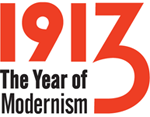Facing the World
Facing the World
Eugène Atget’s photographs of Paris document a cityscape that was about to disappear, as the old city, its places, and people were overtaken by modernization. The sense of a vanishing world captured in these photographs was to be dramatically amplified by the First World War. Art engaged with the social and political reality of the War in different ways. The collision of fierce patriotism and the horror of an unprecedented scope of violence found their way to magazines like L’Elan and Le Mot. Avant-garde groups developed before and after the War aimed not only to formally innovate but also to change the world around them. The Futurists radically rejected the past and dreamed of a new world of technological progress and rapid movement. Russian and British responses to Futurism also privileged dynamism and movement, while Dada formulated a direct response to the grim realities of war and nationalism. Dada artists deployed various strategies to launch vehement attacks against rational bourgeois society, including absurdist performance, poetry, and collage, yet the magazine format epitomized Dada’s status as an international movement and its investment in ephemeral art practices.




































